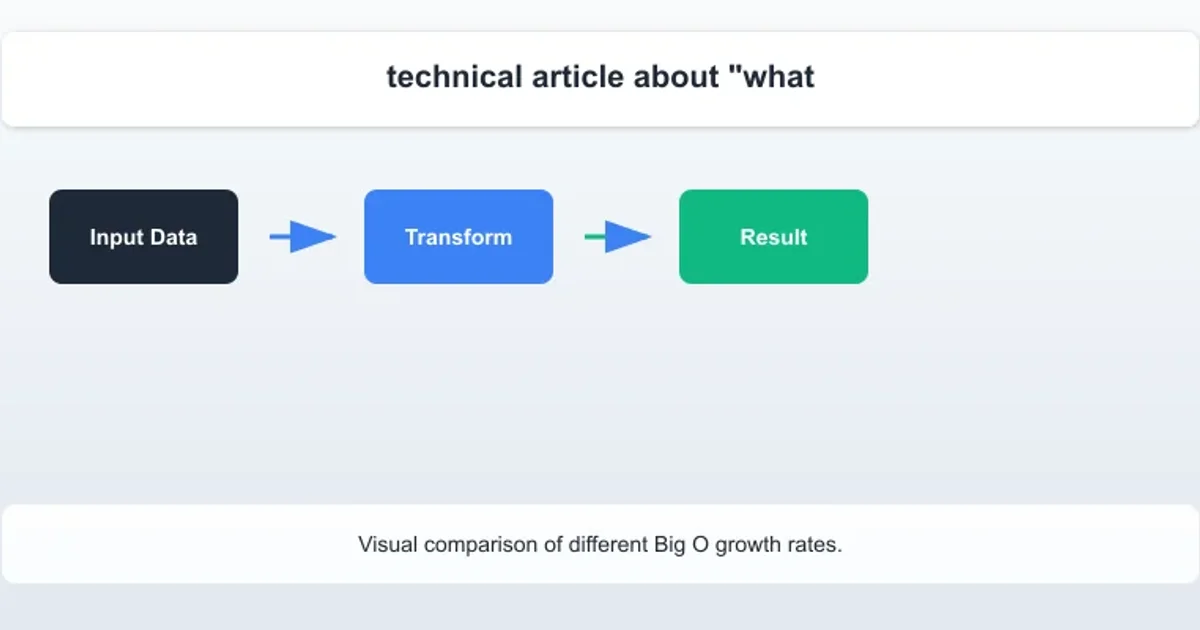what is order of complexity in Big O notation?
Categories:
Understanding Order of Complexity with Big O Notation

Explore Big O notation, a fundamental concept in computer science for analyzing algorithm efficiency and scalability. Learn how to classify algorithms based on their performance characteristics.
In the world of computer science, efficiency is paramount. When developing algorithms, it's not enough for them to simply work; they must also perform well, especially as the amount of data or the problem size grows. This is where Big O notation comes into play. Big O notation provides a standardized way to describe the performance or complexity of an algorithm, focusing on how its runtime or space requirements grow as the input size increases. It helps us compare algorithms and choose the most suitable one for a given task, predicting their behavior under various loads.
What is Big O Notation?
Big O notation, often written as O(f(n)), describes the upper bound of an algorithm's growth rate. It tells us the worst-case scenario for an algorithm's performance. Here, 'n' represents the size of the input, and 'f(n)' is a function that describes how the number of operations (or memory usage) scales with 'n'. We are primarily interested in the dominant term of 'f(n)' and ignore constant factors and lower-order terms, as these become insignificant for large 'n'.
For example, if an algorithm takes 3n^2 + 2n + 5 operations, its Big O complexity would be O(n^2). The n^2 term dominates the growth as 'n' gets large, making 3n^2 the most significant part, and we drop the constant 3.
flowchart TD
A[Algorithm Analysis] --> B{Input Size 'n'}
B --> C{Number of Operations/Memory Usage}
C --> D[Identify Dominant Term]
D --> E[Drop Constants & Lower Order Terms]
E --> F[Big O Notation O(f(n))]
F --> G{Predict Performance for Large 'n'}The process of determining an algorithm's Big O complexity.
Common Orders of Complexity
Understanding the most common Big O complexities is crucial for any developer. Each represents a different growth rate, with some being far more efficient than others, especially for large datasets. Let's explore some of these:
- O(1) - Constant Time: The algorithm takes the same amount of time regardless of the input size. Accessing an array element by index is a classic example.
- O(log n) - Logarithmic Time: The execution time grows logarithmically with the input size. This is very efficient, often seen in algorithms that divide the problem space in half with each step, like binary search.
- O(n) - Linear Time: The execution time grows linearly with the input size. If you double the input, you double the time. Iterating through a list once is an O(n) operation.
- O(n log n) - Linearithmic Time: A very common and efficient complexity for sorting algorithms like Merge Sort and Quick Sort. It's slightly worse than linear but much better than quadratic.
- O(n^2) - Quadratic Time: The execution time grows proportionally to the square of the input size. Often seen in algorithms with nested loops, like Bubble Sort or selection sort.
- O(2^n) - Exponential Time: The execution time doubles with each addition to the input size. These algorithms are highly inefficient and generally only practical for very small input sizes, often found in brute-force solutions.
- O(n!) - Factorial Time: The execution time grows proportionally to the factorial of the input size. Extremely inefficient, typically seen in algorithms that try all possible permutations, like the Traveling Salesperson Problem with a brute-force approach.
def constant_time_example(arr):
# O(1) - Accessing an element by index
return arr[0]
def linear_time_example(arr):
# O(n) - Iterating through all elements
total = 0
for item in arr:
total += item
return total
def quadratic_time_example(arr):
# O(n^2) - Nested loops
count = 0
for i in arr:
for j in arr:
if i == j:
count += 1
return count
def logarithmic_time_example(arr, target):
# O(log n) - Binary search (assuming sorted array)
low = 0
high = len(arr) - 1
while low <= high:
mid = (low + high) // 2
if arr[mid] == target:
return mid
elif arr[mid] < target:
low = mid + 1
else:
high = mid - 1
return -1
Python examples illustrating different Big O complexities.
Why is Big O Important?
Understanding Big O notation is not just an academic exercise; it's a practical skill that directly impacts the quality and scalability of your software. Here's why it's so important:
- Performance Prediction: It allows you to predict how an algorithm will perform as the input size grows, without needing to run it on massive datasets.
- Algorithm Comparison: It provides a common language and framework for comparing the efficiency of different algorithms designed to solve the same problem.
- Resource Optimization: By choosing algorithms with better Big O complexities, you can significantly reduce computation time and memory usage, leading to more efficient and cost-effective systems.
- Scalability: It helps in designing systems that can handle increasing loads and data volumes gracefully, preventing performance bottlenecks as your application grows.
- Interview Preparation: It's a fundamental concept frequently tested in technical interviews, demonstrating a candidate's understanding of core computer science principles.

Visual comparison of different Big O growth rates.
In conclusion, mastering Big O notation is a cornerstone of becoming a proficient software engineer. It empowers you to write not just functional, but also highly performant and scalable code, a critical skill in today's data-intensive world.